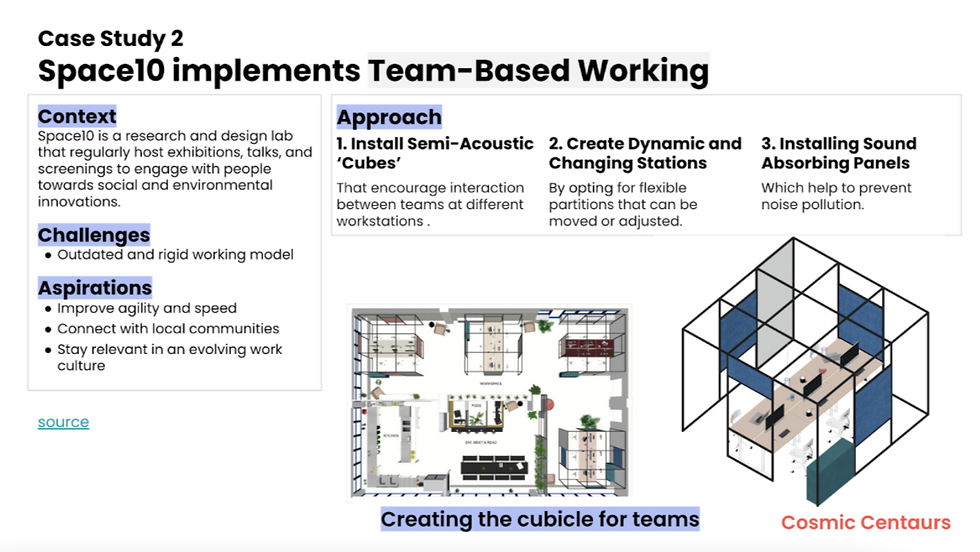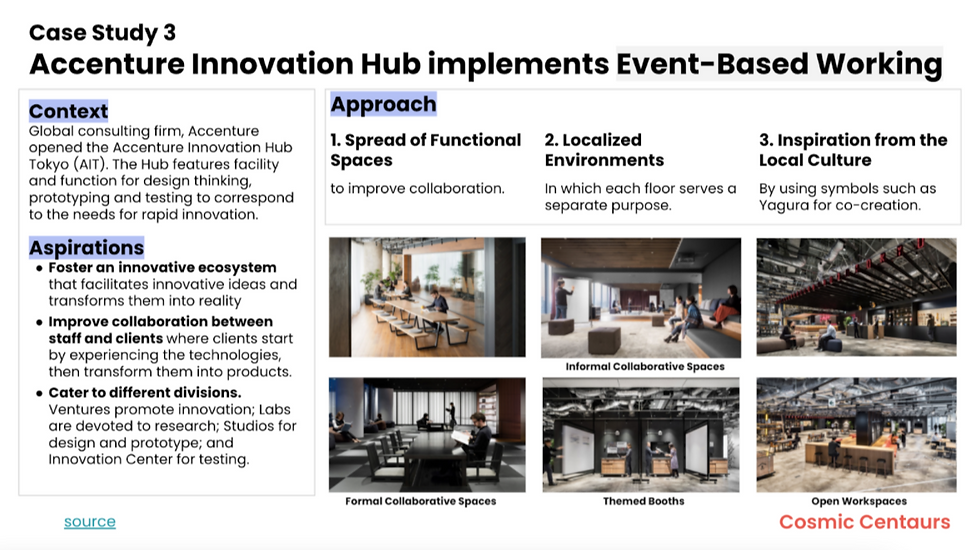What are Flexible Workspaces?
- Cosmic Centaurs

- Mar 22, 2022
- 3 min read
Updated: Jan 2, 2023
& why they might be the trick to bringing employees back to the office.
A flexible workspace is one that is designed to accommodate the diverse needs of employees in a dynamic way. Moreover, 47% of organizations are revisiting their office design standards and 60% are enhancing collaboration spaces in and around the office, (as per CBRE’s 2021 Occupier Sentiment Survey), indicating a recognition that the role of the office will change under a hybrid work model.
As opposed to traditional workplaces, where employees have assigned desks, flexible office spaces expand and adjust to support new business needs and changing team sizes, and to provide employees with a choice of areas and typologies that are best suited to the task at hand.
Flexible workspaces are often used by organizations that also support flexible ways of working. If your company is considering a hybrid work model, it may also be time to consider transforming your office into a flexible workspace.
Here are 3 types of flexible workspaces you could look into:
Activity-based workspaces
Activity-based workspaces (ABW) are designed around the tasks and activities that employees do each and every day. ABW spaces allow employees to move between different spaces that are adapted to whatever task they are currently completing (e.g. moving to a phone booth for a private call, a silent room for focused work, a hot desk for answering emails, etc.).
This type of flexible workplace is increasing in popularity, according to CBRE’s 2021 Occupier Sentiment Survey, 37% of large companies with 10,000 or more employees said they plan to invest in activity-based working. One example is Edenred Singapore (see Fig 1) which recently redesigned their office to accommodate for activity-based working.

Fig 1. Edenred activity-based working case study
According to a study by The University of New South Wales, the main characteristics of Activity-based workspaces are, hot-desking, a variety of space typologies and breakout areas, and flexibility of future fit out with multi-purpose spaces and removable partitions.
Team-based workspaces
In team-based workspaces, employees come to the office primarily to collaborate with others. This type of workspace typically features more spaces to accommodate teams or groups and areas for socializing and community events. The members of a team coordinate to ensure they all come to the office on the same days and individual work is done remotely.
Space10 designed a team-based cubicle as a response to the need for team-based workspaces (see Fig 2).

Fig 2. Space10 team-based working case study
Event-based workspaces
In event-based workspaces, most of the work is done remotely, and the office is used for company events and scheduled meetings. Similarly to team-based workspaces, these spaces are meant to optimize collaboration, with a focus on work with clients and partners, and community building. Individual workspaces are rare if not completely obsolete.
Event-based workspaces are designed to enhance brainstorming, socializing, and learning between employees. (Source: CBRE)
Accenture’s Innovation Hub implemented event based working into their Tokyo location (see Fig 3.)

Fig 3. Accenture Innovation Hub event-based working case study
Flexible working spaces also require a change in mindsets and company cultures. Where employees were required to clock in and out, they are now given autonomy on their work without the enforcement of being confined to a singular space for a certain period of time. With that, physical spaces and management styles have to complement each other for their organizations to be efficient and productive. Despite the many different benefits of hybrid working models, they cannot prosper without the organization’s culture and management being open to flexible work and adapting their processes, tools, policies and management styles to this new way of working.
Get in touch to learn how we can help you redesign your hybrid work model and workspace.




Comments